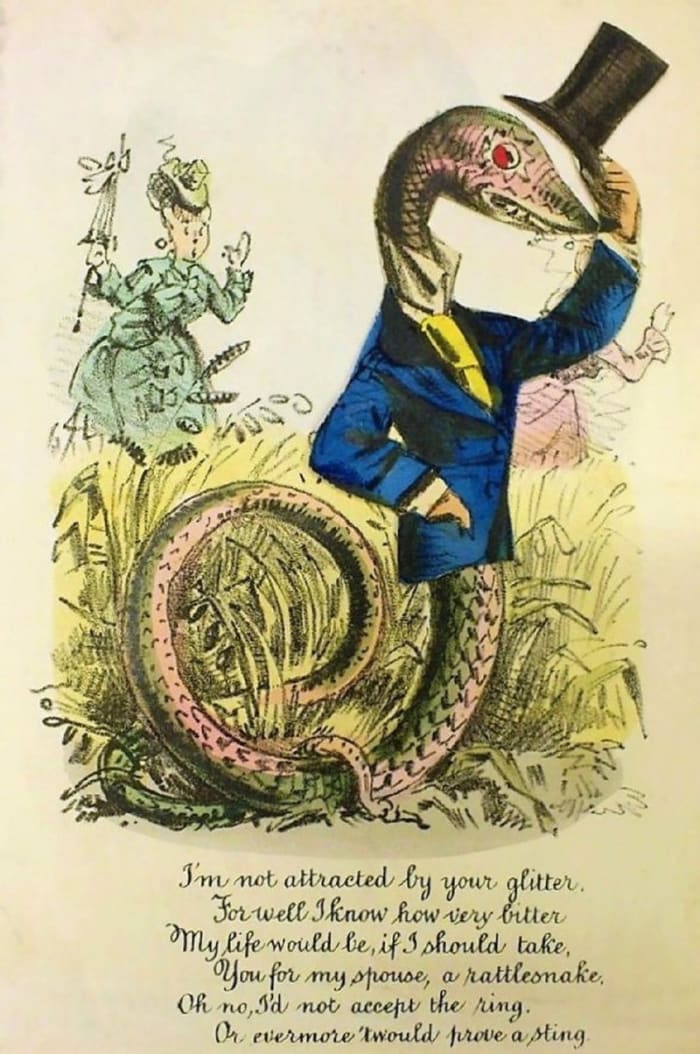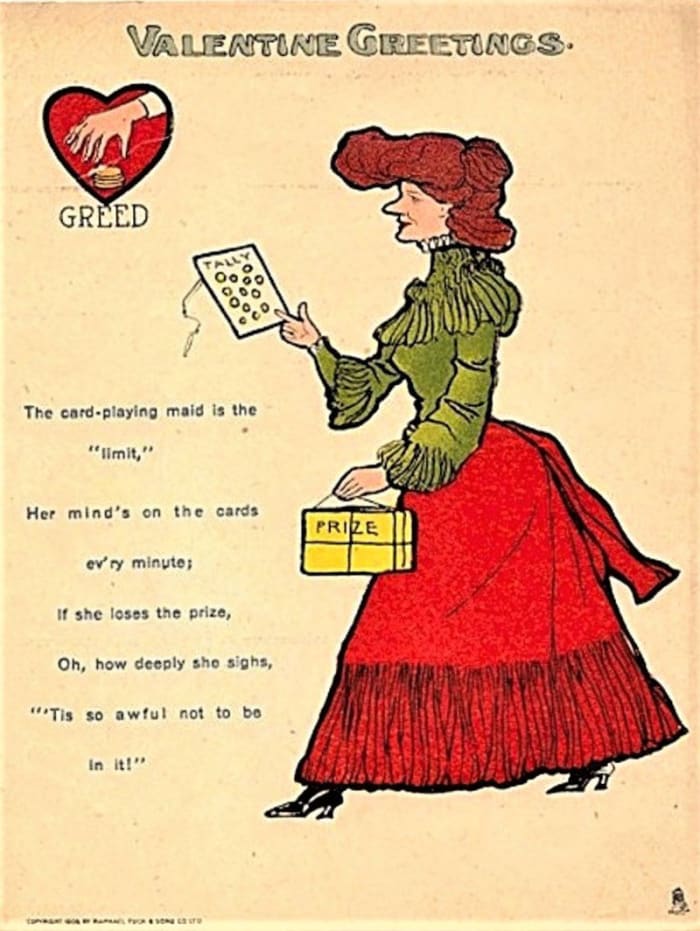When most people think of Valentine’s Day, they think of declaring love for someone with a special card. In the 1840s, it was no different. Valentines with heady poems and fancy flourishes were sent by the thousands by hopeful American and British lovers and secret admirers.
But not everyone wanted to be a secret admirer. Some people wanted to be a secret hater and declare their loathing for someone instead. The most effective way to do that was with the ultimate insult: a vinegar valentine.
Sold in the United States and Britain, these Victorian cards, also called comic valentines, were decorated with garish caricatures and featured a short line or poem that, rather than offer a message of love and affection, insulted the recipient. They were used as an anonymous medium for saying mean things that the senders wouldn’t dare say to someone’s face, a concept familiar today. These cards were essentially an early form of “trolling,” saying mean things to someone online. They ranged from being mildly insulting to rude and crass and sometimes downright cruel and a bit emotionally damaging in the anti-spirit of lampooning Valentine’s Day. Not only that, but to add insult to injury, those who received one in the mail also had to pay the postage for it on delivery. Postmasters sometimes even confiscated these cards as unfit to be mailed.

A slithery vinegar valentine, c. 1870: “I’m not attracted by your glitter, For well I know how very bitter, My life would be, if I should take, You for my spouse, a rattlesnake, Oh no, I’d not accept the ring, Or evermore ‘twould prove a sting.”
Public domain
In his book, Civil War Humor, author Cameron C. Nickels says that vinegar valentines were “tasteless, even vulgar,” and were sent to “drunks, shrews, bachelors, old maids, dandies, flirts, and penny pinchers, and the like.” He also notes that in 1847, sales between love-minded valentines and these sour notes were split evenly at a major New York valentine publisher.
Dr. Annebella Pollen, principal lecturer in history of art and design at the University of Brighton in the UK, and an expert on vinegar valentines who has written papers on them, said that these cards were especially popular during the mid-19th century, when both the U.S. and Britain caught Valentine’s Day fever, a time talked about as “a Valentine’s craze or Valentine’s mania … The press was always talking about this phenomena. These were new, kind of mind-boggling quantities, these millions and millions of cards,” both sweet and sour, she said.
Printers mass-produced Valentine cards that ranged from the expensive, ornate, and sentimental kind to the vinegar variety, which were cheap. “They were designed to expand this holiday into something that could include a whole range of different people and a whole range of different emotions,” Pollen said.
These cards were first produced in America by a variety of printing companies including Elton, Fisher, Strong and Turner. By the 1870s, other entrepreneurs such as New York printer, John McLoughlin, and his cartoonist, Charles Howard, were creating their own lines of cards. While different European companies also produced the cards in the early 19th century, one of the most prestigious firms to create them around 1900 was Raphael Tuck & Sons, “Publishers to Their Majesties the King and Queen of England.”
Some warded off unwanted suitors, while others made fun of people for drinking too much, putting on airs, or engaging in excessive public displays of affection. There were cards telling women they were too aggressive or accusing men of being too submissive, and cards that insulted any profession you could think of — artist, surgeon, saleslady, sailor, carpenter, etc.
Although it’s not known how many of them were sent as a joke or how many were meant to harm, it is clear that some people took their message seriously. In 1885, London’s Pall Mall Gazette reported that a husband shot his estranged wife in the neck after receiving a vinegar valentine that he could tell was from her. There was also a report of someone committing suicide after receiving an insulting valentine, which is exactly what some of them suggested.
As valentines declined in lieu of expensive dinners or gifts, the vinegar valentine became less popular, though some were still selling in the 1970s.

Even the prestigious Raphael Tuck & Sons created vinegar valentines, including this one from 1906: “The card-playing maid is the ‘limit,’ Her mind’s on the cards ev’ry minute, If she sees the prize, Oh, how deeply she sighs, ‘Tis so awful not to be in it!’
Public domain
Compared to other period cards, there aren’t that many surviving examples of vinegar valentines. Pollen attributes this to the fact that people probably didn’t save nasty cards that they got in the mail and were more likely to preserve sentimental valentines like the ones people exchange today.
Some vintage vinegar valentines can be found for sale online at Etsy.com and eBay.com. Most are in the $5 to $40 range, but some are in the $100-$200 range, depending on the age. Some are also in museum and library collections.
These cards are a good reminder that no matter how much people complain that Valentine’s Day makes them feel either too pressured to buy the perfect gift or too sad about being single, it could be worse: You could get an insulting anonymous card proclaiming that you’re a big jerk.
You May Also Like:
Treat That Someone Special to a Vintage Valentine









